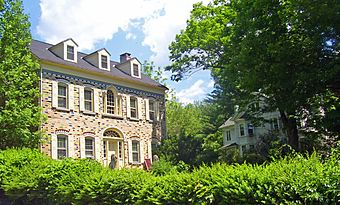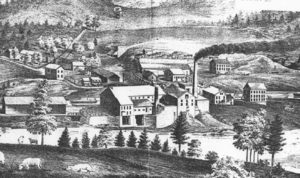Snyder Estate Natural Cement Historic District facts for kids
Quick facts for kids |
|
|
Snyder Estate Natural Cement
Historic District |
|

Houses of Andrew (left) and Charles Snyder along Route 213, 2008
|
|
| Location | Rosendale, NY |
|---|---|
| Nearest city | Kingston |
| Area | 275 acres (111 ha) |
| Built | 1825-1958 |
| Architectural style | Federal |
| NRHP reference No. | 92000695 |
| Added to NRHP | 1992 |
The Snyder Estate Natural Cement Historic District is a special historical area in Rosendale, New York, United States. It covers about 275 acres and includes old factories, homes, and mines. This district shows where "Rosendale cement" was made for many years.
This area has 122 important historical spots. These include the remains of five cement factories and the homes of the Snyder family, who owned the land. The buildings range from the 1825 Delaware and Hudson Canal bed to factories built just before 1970. The district was added to the National Register of Historic Places in 1992 because of its importance.
Contents
Exploring the Snyder Estate's Geography
The Snyder Estate area looks a bit like the letter "r" on a map. It's surrounded by roads and a creek on three sides. Two large hills, part of the Shawangunk Ridge, stand tall in the district. They rise over 300 feet (91 meters) above the nearby creek.
Between these hills, in a narrow valley, are the remains of one of the biggest cement factories. An old Wallkill Valley Railroad track, called a siding, runs from there. This siding helped move cement to other places. You can also find old mines and quarries dug into the sides of both hills. Most of the land is covered in woods, but some areas along the roads are old fields now covered in grass.
A Look Back at Rosendale Cement History
Making natural cement started here soon after it was discovered in 1825. James McEntee, an engineer working on the D&H Canal, found it. By the late 1800s, production was huge, making about 4 million barrels each year. However, demand for natural cement dropped in the 1900s because of a new type called Portland cement. The last cement company in the district closed in 1970.
The 1800s: Cement's Big Start
The Snyder family had owned and farmed this land since 1755. In 1809, Jacob Lowe Snyder, a newlywed, got a house and a gristmill (a mill for grinding grain) from his parents. This house, called the Century House, is the oldest building in the district with a known age.
In 1825, Jacob Snyder allowed the Delaware and Hudson Canal Company to build a canal across his land. He asked them to build a slip (a place to load boats) for his farm goods and a bridge to his mill. While digging, workers found special rock called dolostone. This rock had the right amount of clay minerals to make natural cement without adding anything else.
The canal company quickly started making cement. This new cement was perfect for building the canal itself. In 1830, Snyder leased part of his land to Watson Lawrence, who already had a cement plant nearby. Soon, many other mines and cement plants opened in the area.
Snyder used the money from the Lawrence Cement Company to make better quality cement. He got big government projects, like New York City's Old Croton Aqueduct and the Brooklyn Navy Yard docks. This made "Rosendale cement" famous for its quality. It even became a general term for any natural cement, no matter where it was made. But this popularity eventually caused money problems, and the company closed in 1858.
Lawrence kept control of the new Lawrenceville Cement Company for a short time. Then, William Beach took over and made the factories even bigger. This was just in time for a huge increase in demand after the American Civil War. When Beach died in 1881, his son, William N. Beach II, took charge.
The younger Beach used the new Wallkill Valley Railroad to ship cement. He built a special track, a siding, to the plant. This meant cement could be sent across the country using the New York Central Railroad network. This change meant less reliance on the canal, which eventually stopped carrying loads of cement.
The 1900s: Changes and Challenges
As the 1900s began, natural cement was very popular. The Snyder family was proud that their cement was used in the Brooklyn Bridge. Beach even built another new plant to meet the demand. However, a cheaper type of cement, Portland cement, was developed. This caused the market for Rosendale cement to drop by 90% in just ten years. Local businessman Samuel Coykendall tried to save the industry by combining all the local companies, but it didn't work.
In 1911, a court made William Snyder sell his company to 21-year-old Andrew J. Snyder II. Andrew took apart one of the large plants and built a smaller one. He kept making cement on a smaller scale through the 1920s. Later, an investor from Cleveland, Ohio leased part of the property and started the Interstate Cement Company.
The Great Depression soon ended that business. By 1935, Andrew Snyder owned the company completely, calling it Century Cement Manufacturing Co. He kept the company going by letting mushroom growers use the abandoned Beach Mine. This mine eventually produced five tons of mushrooms a day until 1960.
Around this time, it was discovered that Portland cement worked even better when mixed with natural cement. This 80:20 blend was great for building highways, which were being built quickly across the country. By World War II, cement production was increasing again.
Production slowed during the war but grew even more afterward. This was because of the new Interstate Highway System. In 1954, Rosendale cement was used for parts of the New York State Thruway. But this was the last big project to use it.
Snyder also looked into making Portland cement. Geologists found plenty of limestone in the Hudson Valley, which is needed for Portland cement. So, in 1958, the company bought a plant from a Swiss company. It was built next to the existing factories and started making Portland cement three years later. Around the same time, scientists created an additive for Portland cement that made the Rosendale mix unnecessary and even cheaper.
Snyder and his team tried to keep up, but it was hard. The market for natural cement was almost gone. In 1970, Snyder finally stopped production, nearly 150 years after Rosendale cement was first found. He passed away five years later.
Keeping History Alive: Preservation Efforts
People realized how important this area was, not just locally but for the whole country. In 1978, an effort began to make it a National Historic Landmark, but it wasn't finished. The Century House Historical Society (CHHS) bought 19 acres around the 1809 Century House. This society runs the property as a museum. It teaches visitors about the house and the American natural cement industry.
In its final years, one of the few uses for Rosendale cement was restoring old buildings. When the factory closed, builders had no source for this special material. In 2004, Edison Coatings, Inc., started making "Rosendale Natural Cement Products." This company now offers an authentic, historically accurate replacement for the original cement.
Important Places in the District
Many places in the district are important. None are listed separately on the Register yet, except for parts of the canal bed, which is a National Historic Landmark.
The Century House Historical Society (CHHS) runs the site as a museum. It is open to the public on Sunday afternoons in the summer. The museum is also known as the "Century House Historical Society Museum" and the "Snyder Estate Museum."
The Century House: A Historic Home
Jacob Lowe Snyder's house, built in 1809, is the heart of the CHHS property. It's the oldest building in the district. It was updated in the 1940s.
The house has the Cement Industry Museum. Here you can see old tools and photos from the Rosendale cement industry. Rosendale Natural Cement was used in many famous buildings. These include the Brooklyn Bridge, the base of the Statue of Liberty, parts of the U.S. Capitol, the Washington Monument, Grand Central Terminal, and the Croton Aqueduct. It was also used in the foundation of the Empire State Building and many other public projects. The museum also displays horse-drawn carriages and sleighs.
Andrew J. Snyder I House: The Ceramic Brick Home
This house is also known as the Ceramic Brick House. It was built in 1887 as a grand Second Empire-style mansion with a fancy roof. In 1950, its windows and roof were changed to a more common style. It was also covered with colorful glazed bricks from Leeds. Even with these big changes, the house kept its historical status because its original structure and inside layout are still the same.
Canal Infrastructure: Remnants of the Past
Besides the canal bed, other parts of the canal remain here. There's a waste weir (a small dam) next to it. West of Binnewater Road, you can find a reservoir that once kept the canal full. The slip built for Snyder is also still there. It might be the only original slip left from the canal's construction.
Widow Jane Mine: An Underground Wonder
The Widow Jane Mine is an old mine dug into a hillside. It's the oldest cement mine on the property. It was built using a "room and pillar" method. This means large pillars of rock were left to hold up the ceiling. It looks like a huge underground room with many pillars. Most of the deep parts of the mine are filled with water. However, the entrance area is open for visitors. Many events, like concerts, are held here in the summer because of its unique sound.




